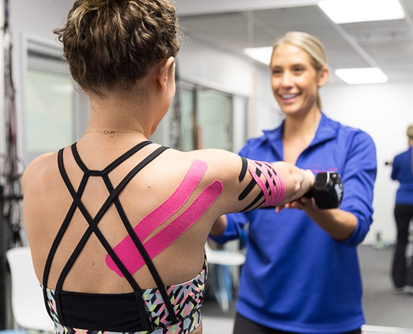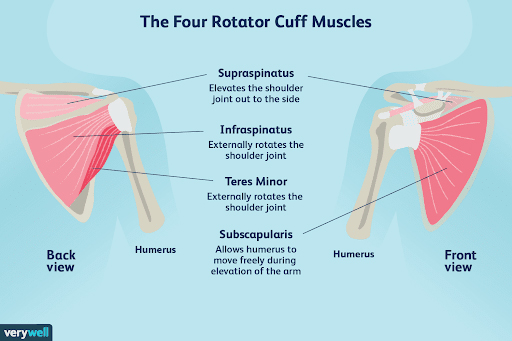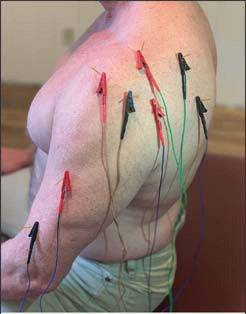Physical Therapy for Shoulder Tendonitis
What is Shoulder Tendonitis?
Shoulder tendonitis occurs when the tendons connecting shoulder muscles to bone are injured, irritated, or inflamed. This condition causes pain during daily activities, including reaching overhead, carrying, lifting, or pushing and pulling. Pain can also make tasks like sleeping more difficult and may lead to decreased range of motion and strength. Before your shoulder pain becomes a bigger problem than you can handle, seek treatment by a physical therapist. Here at Symmetry Physical Therapy, we use a full comprehensive approach to treating shoulder tendonitis and other shoulder conditions.
How do I know if I have Shoulder Tendonitis?
When dealing with shoulder pain there are some cardinal signs that can alert you if you may be dealing with shoulder tendonitis. Some of these presentations are: having a limited range of motion; you find reaching overhead or behind your back is causing you pain and discomfort. Limited strength; lifting/carrying/pushing/pulling or any other strength related tasks are causing your shoulder pain. Tenderness of the muscles or tendons surrounding the joint, or possibly other sensations such as clicking and popping. Physical therapists at our Downtown/Brickell Symmetry Physical Therapy location can help you with special tests that are meant to specify which muscles are affected so we can better help in your rehabilitation.

Which Muscles Are Affected with Shoulder Tendonitis?
The most common muscles that are affected in the shoulder are the rotator cuff muscles. These small, stabilizing muscles help with rotating the shoulder in and out. They also help with stabilizing the ball and socket joint and preventing dislocation. These are the muscles that usually are the least targeted in everyday training, but play the biggest role in shoulder health. The rotator cuff consists of four muscles, supraspinatus, infraspinatus, teres minor and subscapularis. Usually, the first three muscles mentioned are the likely injured tendons due to weakness in external rotation.

What can Physical Therapy treatment do for Shoulder tendonitis?
Treatment for Shoulder tendonitis here at Symmetry is achieved in stages. The first phase is to reduce pain and inflammation of the tendon. This is best achieved with manual therapy including joint mobilizations, soft tissue mobilization (STM), dry needling with electrical stimulation, and Winback Tecar therapy.
As we start to remove the pain and inflammation, we try to strengthen and stabilize the rotator cuff muscles and improve their flexibility to address the root cause of the problem. Many times, pain is a result of a deeper problem, compensation or improper posture/movement pattern. It is our responsibility to find out exactly what is causing the pain and then fix it. The later phases of rehabilitation are then to re-train these muscles and allow for improved biomechanics and arthro-kinematics of the joint necessary for improved movement patterns and fixing the origin of the problem. In these phases, strengthening, stretching, and other exercises are necessary to address movement compensations and avoid reinjuries or further injuries.

Dry needling for Shoulder Tendonitis
Dry Needling is a treatment used in physical therapy to assist in the healing of tissues and the removal of increased inflammation of the injured area. The treatment is used in combination with electrical stimulation (E-stim) helps to increase opioid production of the body, blocks pain in tissues, increases blood flow, and removes byproducts and waste from affected tissues. Any trigger points in muscles and tendons of the shoulders can also lead to improper movement patterns. Dry needling can help to release the acetylcholine trapped in trigger points to allow for optimal movements of muscles. Overall dry needling is a highly effective strategy used for treatment of shoulder pathologies.
WinBack Tecar Therapy for Shoulder Tendonitis?
Winback TeCar Therapy uses radiofrequency current to increase the body’s natural healing process and decrease recovery time. Here’s how Winback TeCar therapy can help Tennis Elbow:
- Increased blood flow: To improve blood circulation to the affected area. Increased blood flow will help to deliver oxygen and nutrients to the affected tissues. It will aslo remove waste products and facilitate the healing process.
Pain reduction: Tecar therapy may help alleviate pain associated with shoulder tendonitis. The heat generated by the therapy can enhance blood flow, improve muscle relaxation, and help to realign abnormal collagen fibers and scar tissue.
- Reduction of inflammation: Shoulder tendonitis involves inflammation of the tendons. Tecar therapy may help to reduce inflammation and promote lymphatic drainage
Winback used following dry needling can help to catapult the effects of healing in the targeted tissue to better assist in the healing of your injured shoulder.
Shoulder pain caused by tendonitis is a nagging injury that can worsen if not addressed promptly. Here at Symmetry Physical Therapy, we use a multi-modal approach of treating to better assist in the rehabilitation of your injury. As listed above, there are many different causes and treatments that are possible when dealing with shoulder tendonitis. We find the root cause and solve the problem of your pain helping you get back to a pain-free lifestyle. If you suspect you have a shoulder injury, and are looking for a Physical Therapist, come see us at Symmetry Physical Therapy, located in the Miami/Brickell downtown area, where we provide an in-depth assessment and treatment strategies so we can help you get back to normal
Feel free to give us a call at (305) 331 2277 to schedule an appointment.
